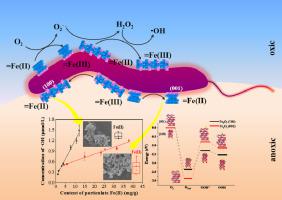Water Research ( IF 11.4 ) Pub Date : 2021-02-28 , DOI: 10.1016/j.watres.2021.116988 Ruixia Han , Jitao Lv , Suhuan Zhang , Shuzhen Zhang

|
Microbial dissimilatory iron reduction and aerobic oxidation affect the biogeochemical cycles of many elements. Although the processes have been widely studied, the underlying mechanisms, and especially how the surface structures of iron oxides affect these redox processes, are poorly understood. Therefore, {001} facet-dominated hematite nanoplates (HNP) and {100} facet-dominated hematite nanorods (HNR) were used to explore the effects of surface structure on the microbial dissimilatory iron reduction and aerobic oxidation processes. During the reduction stage, the production of total Fe(II) normalized by specific surface area (SSA) was higher for HNP than HNR due to steric effects and the ligand-bound conformation of the connection between iron on different exposed facets and electron donors from microorganisms. However, during the aerobic oxidation stage, both the SSA- and Fe(II)-normalized reactive oxygen species (ROS), including hydrogen peroxide (H2O2) and hydroxyl radical (•OH), were higher for HNR than HNP. Theoretical calculation results showed that the {100} facets exhibited a lower activation energy barrier for oxygen reduction reaction than {001} facets, supporting the experimental observation that {100} facet-dominated HNR had a higher ROS production efficiency than {001} facet-dominated HNP. These results indicated that surface characteristics not only mediated the microbial reduction of Fe(III) but also affected the aerobic oxidation of microbially reduced Fe(II). Accessibility of electron donors to surface iron atom determined the reduction of Fe(III), and activation energy barrier for oxygen reduction by surface Fe(II) dominated the ROS production during the redox processes. This study advances our understanding of the mechanisms through which ROS are produced by iron (oxyhydr)oxides during microbial dissimilatory iron reduction and aerobic oxidation processes.
中文翻译:

赤铁矿面介导的微生物异化铁的还原和好氧氧化过程中活性氧的产生
微生物异化铁还原和好氧氧化影响许多元素的生物地球化学循环。尽管已经对该方法进行了广泛研究,但对潜在的机理,尤其是氧化铁的表面结构如何影响这些氧化还原过程的了解却很少。因此,使用{001}面为主的赤铁矿纳米板(HNP)和{100}面为主的赤铁矿纳米棒(HNR)来探讨表面结构对微生物异化铁还原和好氧氧化过程的影响。在还原阶段,由于空间效应和铁在不同暴露面与电子供体之间的连接的配体结合构象,HNP的HFe的总Fe(II)的生成量要比HNR高。微生物。然而,2 O 2)和羟基自由基(•OH),对于HNR而言要比HNP高。理论计算结果表明,{100}刻面对氧还原反应的活化能垒比{001}刻面低,支持实验观察到{100}刻面为主的HNR的ROS生成效率高于{001}刻面。占主导地位的HNP。这些结果表明,表面特性不仅介导了Fe(III)的微生物还原,而且还影响了微生物还原的Fe(II)的好氧氧化。电子供体与表面铁原子的可及性决定了Fe(III)的还原,而表面Fe(II)还原氧的活化能垒主导了氧化还原过程中ROS的产生。











































 京公网安备 11010802027423号
京公网安备 11010802027423号